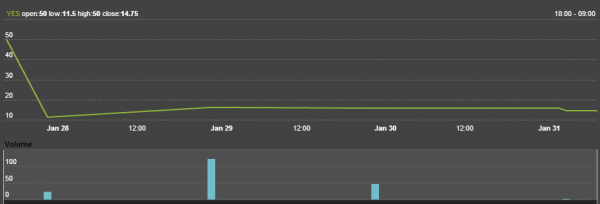January 31, 2014
According to one pool of forecasters, most probably not.
As part of a public atrocities early-warning system I am currently helping to build for the U.S. Holocaust Memorial Museum’s Center for the Prevention of Genocide (see here), we are running a kind of always-on forecasting survey called an opinion pool. An opinion pool is similar in spirit to a prediction market, but instead of having participants trade shares tied the occurrence of some future event, we simply ask participants to estimate the probability of each event’s occurrence. In contrast to a traditional survey, every question remains open until the event occurs or the forecasting window closes. This way, participants can update their forecasts as often as they like, as they see or hear relevant information or just change their minds. With generous support from Inkling, we started up our opinion pool in October, aiming to test and refine it before our larger early-warning system makes its public debut this spring (we hope).
So far, we have only recruited opportunistically among colleagues and professional acquaintances, but we already have more than 70 registered participants. In the first four months of operation, we have used the system to ask more than two dozen questions, two of which have since closed because the relevant events occurred (mass killing in CAR and the Geneva II talks on Syria). Over the next few years, we aim to recruit a large and diverse pool of volunteer forecasters from around the world with some claim to topical expertise or relevant local knowledge. The larger and more diverse our pool, the more accurate we expect our forecasts to be, and the wider the array of questions we can ask. (If you are interested in participating, please drop me a line at ewp <at> ushmm <dot> org.)
A few days ago and prompted by a couple of our more active members, I posted a question to our pool asking, “Before 1 March 2014, will any massacres occur in Ukraine?” As of this morning, our pool had made a total of 13 forecasts, and the unweighted average of the latest of those estimates from each participating forecaster was just 15 percent. Under the criteria we specified (see Background Information below), this forecast does not address the risk of large-scale violence against or among armed civilians, nor does it exclude the possibility of a series of small but violent encounters that cumulatively produce a comparable or larger death toll. Still, for those of us concerned that security forces or militias will soon kill nonviolent protesters in Ukraine on a large scale, our initial forecast implies that those fears are probably unwarranted.

Obviously, we don’t have a crystal ball, and this is just an aggregation of subjective estimates from a small pool of people, none of whom (I think) is on the scene in Ukraine or has inside knowledge of the decision-making of relevant groups. Still, a growing body of evidence shows that aggregations of subjective forecasts like this one can often be usefully accurate (see here), even with a small number of contributing forecasters (see here). On this particular question, I very much hope our crowd is right. Whatever happens in Ukraine over the next few weeks, though, principle and evidence suggest that the method is sound, and we soon expect to be using this system to help assess risks of mass atrocities all over the world in real time.
Background Information We define a “massacre” as an event that has the following features:
At least 10 noncombatant civilians are killed in one location (e.g., neighborhood, town, or village) in less than 48 hours. A noncombatant civilian is any person who is not a current member of a formal or irregular military organization and who does not apparently pose an immediate threat to the life, physical safety, or property of other people.
- The victims appear to have been the primary target of the violence that killed them.
- The victims do not appear to have been engaged in violent action or criminal activity when they were killed, unless that violent action was apparently in self-defense.
- The relevant killings were carried out by individuals affiliated with a social group or organization engaged in a wider political conflict and appear to be connected to each other and to that wider conflict.
Those features will not always be self-evident or uncontroversial, so we use the following series of ad hoc rules to make more consistent judgments about ambiguous events.
- Police, soldiers, prison guards, and other agents of state security are never considered noncombatant civilians, even if they are killed while off duty or out of uniform.
- State officials and bureaucrats are not considered civilians when they are apparently targeted because of their professional status (e.g., assassinated).
- Civilian deaths that occur in the context of operations by uniformed military-service members against enemy combatants are considered collateral damage, not atrocities, and should be excluded unless there is strong evidence that the civilians were targeted deliberately. We will err on the side of assuming that they were not.
- Deaths from state repression of civilians engaged in nonviolent forms of protest are considered atrocities. Deaths resulting from state repression targeting civilians who were clearly engaged in rioting, looting, attacks on property, or other forms of collective aggression or violence are not.
- Non-state militant or paramilitary groups, such as militias, gangs, vigilante groups, or raiding parties, are considered combatants, not civilians.
We will use contextual knowledge to determine whether or not a discrete event is linked to a wider conflict or campaign of violence, and we will err on the side of assuming that it is. Determinations of whether or not a massacre has occurred will be made by the administrator of this system using publicly available secondary sources. Relevant evidence will be summarized in a blog post published when the determination is announced, and any dissenting views will be discussed as well.
View All Blog Posts